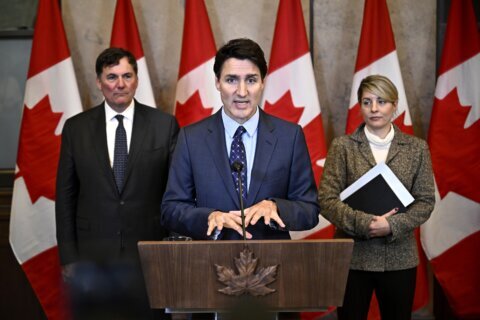Treasury bond investors these days may be unnerved with news of the recent downgrade of the U.S. government’s creditworthiness by Fitch Ratings, but another ongoing phenomenon warrants close scrutiny as well — the continued steep yield curve inversion.
In normal circumstances, the curve charting interest rates on bonds of varying maturities slopes upward. This is because investors typically demand higher returns for the added risk of holding a bond over a longer period.
However, the yield curve inverts when interest rates on short-term bonds trend higher than those on long-term bonds.
[Sign up for stock news with our Invested newsletter.]
When investors start to anticipate slower economic growth or even a recession, they tend to shift their investments from riskier assets to safer ones, such as long-term Treasurys. This increased demand for long-term bonds pushes their prices up and, inversely, their yields down. At the same time, short-term yields might increase because the Federal Reserve is raising interest rates.
“In an effort to combat inflation, the Fed has aggressively hiked interest rates in 2022 in an attempt to cool down the economy,” says Mark Andraos, associate portfolio manager at Regency Wealth Management. “The reality is, the Fed can really only control the short end of the yield curve, which is why we’re seeing such an inversion.”
Many investors believe that an inverted yield curve heralds an upcoming recession. This is because they expect that short-term rates, which are closely tied to the health of the economy, will eventually fall from where they are now. Investors are betting the Fed will eventually need to lower interest rates to stimulate a weakening economy.
However, an inverted yield curve isn’t always predictive of a recession. “Most market participants believe that an inverted yield curve is an indicator of an upcoming recession, but there is an old expression that says five out of the last four recessions have been predicted by an inverted yield curve, meaning it’s not exactly the greatest indicator of an upcoming recession,” Andraos says.
Should a recession be on the horizon, investors can attempt to reduce risk in their portfolio by holding bond exchange-traded funds, or ETFs. Compared to equity ETFs, bond ETFs tend to be much less volatile, which can help reduce fluctuations and drawdowns. In addition, many bond ETFs pay out monthly distributions, which can be a boon for investors seeking consistent income.
Here are nine of the best bond ETFs to buy in 2023:
| ETF | Expense ratio | 30-day SEC yield |
| iShares Core U.S. Aggregate Bond ETF (ticker: AGG) | 0.03% | 4.2% |
| Vanguard Short-Term Treasury ETF (VGSH) | 0.04% | 5% |
| Vanguard Long-Term Treasury ETF (VGLT) | 0.04% | 4.3% |
| iShares Aaa — A Rated Corporate Bond ETF (QLTA) | 0.15% | 5.1% |
| Vanguard Total International Bond ETF (BNDX) | 0.07% | 3.4% |
| SPDR Bloomberg High Yield Bond ETF (JNK) | 0.4% | 8.2% |
| SPDR Bloomberg Investment Grade Floating Rate ETF (FLRN) | 0.15% | 5.8% |
| Invesco BulletShares 2024 Corporate Bond ETF (BSCO) | 0.1% | 5.7% |
| Invesco Treasury Collateral ETF (CLTL) | 0.08% | 5.2% |
iShares Core U.S. Aggregate Bond ETF (AGG)
One of the simplest ways to passively track a wide swath of the overall U.S. bond market is via an aggregate bond ETF like AGG. By tracking the popular Bloomberg US Aggregate Bond Index benchmark, AGG provides exposure to over 11,000 U.S. dollar-denominated bonds.
AGG is extremely diversified in terms of both issuer and maturity. AGG features both government- and corporation-issued bonds ranging from one to 20 years in maturity. Best of all, the ETF charges a low expense ratio of just 0.03%.
Vanguard Short-Term Treasury ETF (VGSH)
“Due to the inverted yield curve, investors could benefit from owning short-dated Treasurys, as short-term rates between zero and two years are yielding higher around 5%, while longer-dated Treasurys around three to 10 years are yielding closer to 4% to 4.5%,” Andraos says.
A popular ETF for short-term Treasury bond exposure is VGSH, which holds Treasurys of one to three years in maturity. Due to the inverted yield curve, VGSH is currently paying a yield to maturity of 4.9%. Like most Vanguard ETFs, VGSH keeps fees low, charging an expense ratio of just 0.04%.
Vanguard Long-Term Treasury ETF (VGLT)
“The risk to owning shorter-dated treasuries at this juncture would be if intermediate or longer-term rates dropped further, as longer-dated bonds are more interest rate sensitive and would benefit more from the inverse relationship between yields and prices,” Andraos says.
Investors banking on the possibility of a recession and subsequent cut in interest rates can use a long-term Treasury ETF like VGLT to capitalize. With an average duration of 16 years, VGLT is expected to gain 16% in value should interest rates be cut by 100 basis points, all else being equal.
iShares Aaa — A Rated Corporate Bond ETF (QLTA)
Treasurys may historically have been regarded as the “flight to safety” asset, but the recent credit rating downgrade by Fitch has given many investors pause. As an alternative, investors can consider diversifying with high-quality bonds issued by corporations, or investment-grade corporate bonds.
The highest-quality investment grade corporate bonds can be found in QLTA, which only holds Aaa-to-A-rated U.S. corporate bonds. This gives the ETF lower credit risk compared to most corporate bond ETFs. QLTA currently pays a yield to maturity of 5.3% and charges a 0.15% expense ratio.
[See 10 of the Best Blue-Chip Stocks to Buy]
Vanguard Total International Bond ETF (BNDX)
Another way investors can sidestep the current turmoil in the U.S. Treasury market is by diversifying to international bonds with an ETF like BNDX. This ETF tracks the Bloomberg Global Aggregate ex-USD Float Adjusted RIC Capped Index (USD Hedged), currently holding around 7,000 issues.
BNDX currently holds investment-grade government and corporate bonds from countries such as Japan, France, Germany, Italy, Canada, the U.K., Spain, Australia and more. The ETF pays a yield to maturity of 5.3% and charges a 0.07% expense ratio.
SPDR Bloomberg High Yield Bond ETF (JNK)
Bond investing doesn’t have to be “low risk, low reward.” Investors willing to accept higher credit risk in the pursuit of greater yields can consider non-investment grade bonds. Also known as “high yield” or “junk” bonds, they offer much higher interest rates to compensate for the greater risk of default.
To invest in high-yield bonds, investors can choose an ETF like JNK. This ETF tracks the Bloomberg High Yield Very Liquid Index, which as its name suggests screens holdings for sufficient liquidity. Right now, JNK is paying a yield to maturity of 8.6%, but charges a 0.4% expense ratio.
SPDR Bloomberg Investment Grade Floating Rate ETF (FLRN)
For investors looking to take advantage of the current high-interest-rate environment, floating rate bonds can present an attractive proposition. Unlike fixed-rate bonds, the interest payments on floating rate bonds adjust with market rates, which makes them attractive when rates rise and less susceptible to losses than nominal bonds.
To gain exposure to floating rate bonds, investors can consider an ETF such as FLRN. This ETF tracks the Bloomberg U.S. Dollar Floating Rate Note < 5 Years Index. This ETF is currently paying a yield to maturity of 6.1% with very low interest rate risk. FLRN charges a 0.15% expense ratio.
Invesco BulletShares 2024 Corporate Bond ETF (BSCO)
“While yields are historically attractive, many investors may be hesitant in the midst of higher interest rate volatility and uncertainty around future returns in their bond portfolio,” says Brian McMullen, fixed income ETF strategist at Invesco. To mitigate this, consider a target-maturity bond ETF like BSCO.
BSCO differs from most bond ETFs by having a defined maturity date. The fund will terminate on Dec. 15, 2024, paying out its net asset value, much like an individual bond does. “BulletShares ETFs like BSCO can offer investors greater visibility around the future return profile,” McMullen says.
Invesco Treasury Collateral ETF (CLTL)
“For investors looking to park cash and access high-quality yield, CLTL should remain an attractive vehicle while the Fed keeps short-term rates elevated,” McMullen says. This is because CLTL holds Treasury bills, or T-bills, with less than 12 months remaining until maturity.
CLTL is currently paying a yield to maturity of 5.4% and is also competitive in terms of fees. “For investors looking to access historically high yields on T-bills with minimal duration, CLTL is one of the lowest cost vehicles to do so, with an expense ratio of 0.08%,” McMullen says.
More from U.S. News
7 Best Money Market Funds to Buy for Safety
10 Best Low-Cost Index Funds to Buy
10 Long-Term Investing Strategies That Work
9 of the Best Bond ETFs to Buy Now originally appeared on usnews.com
Update 08/09/23: This story was previously published at an earlier date and has been updated with new information.







